Innovation and Business Development Report: Technology One Case Study
VerifiedAdded on 2020/02/24
|11
|1943
|39
Report
AI Summary
This report examines the concepts of innovation and business development within the context of a changing global economy, focusing on the evolution of business models in response to technological advancements and increased customer-centricity. It explores the importance of business model development, particularly for IT companies, and introduces key concepts like e-business archetypes, business model frameworks, and cost-revenue architecture. The report uses Technology One, an Australian software company, as a case study, analyzing its adaptation to big data and its value chain strategies. It highlights the significance of value proposition, resources, capabilities, and design principles in shaping a successful business model. The analysis underscores the need for continuous improvement in business models and value chains to meet customer needs and maintain a competitive advantage in the industry. The report concludes with recommendations for enhancing the business model and value chain to ensure long-term success.

Running head: INNOVATION AND BUSINESS DEVELOPMENT
Innovation and Business Development
Name of the Student
Name of the University
Author note
Innovation and Business Development
Name of the Student
Name of the University
Author note
Paraphrase This Document
Need a fresh take? Get an instant paraphrase of this document with our AI Paraphraser
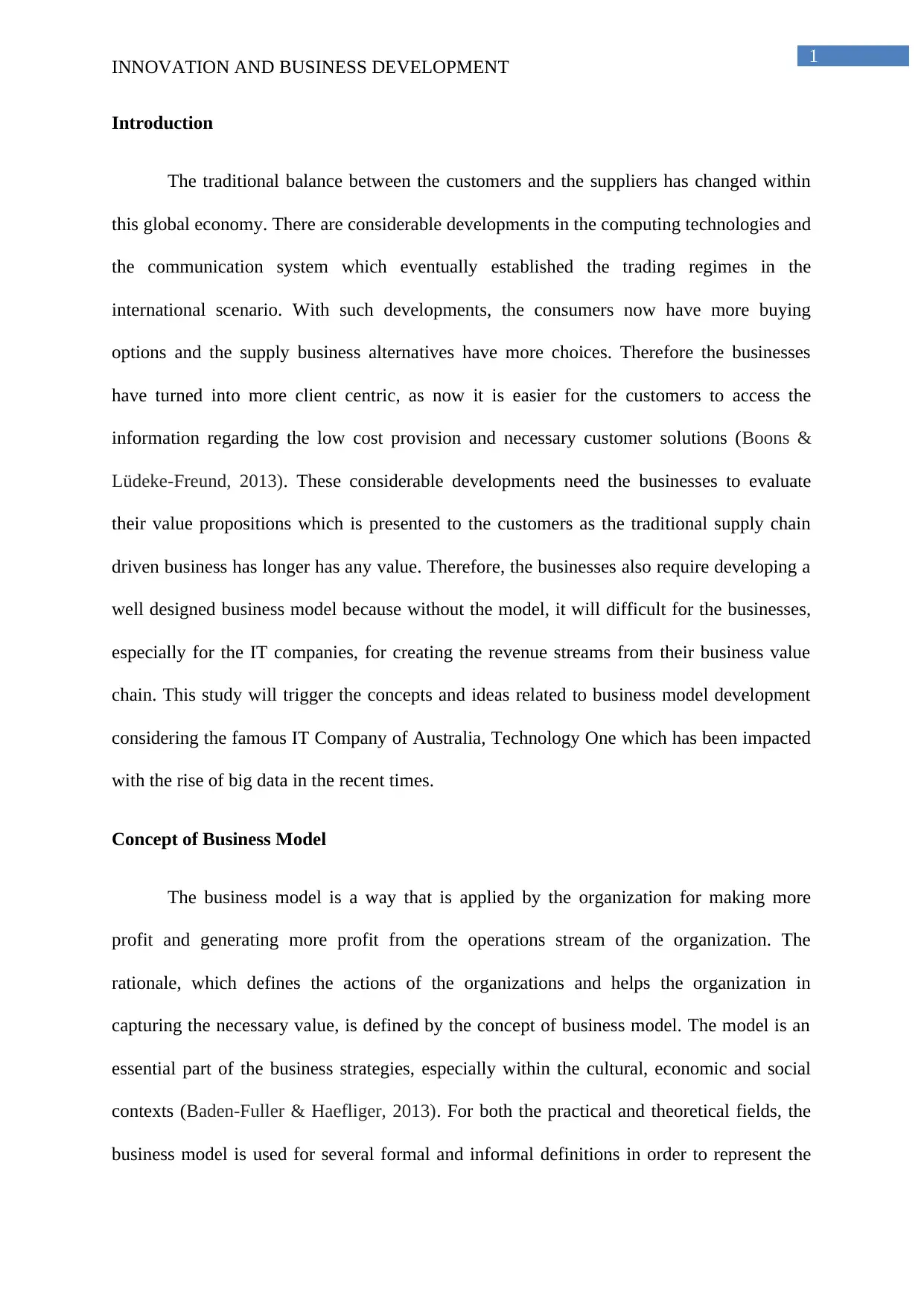
1
INNOVATION AND BUSINESS DEVELOPMENT
Introduction
The traditional balance between the customers and the suppliers has changed within
this global economy. There are considerable developments in the computing technologies and
the communication system which eventually established the trading regimes in the
international scenario. With such developments, the consumers now have more buying
options and the supply business alternatives have more choices. Therefore the businesses
have turned into more client centric, as now it is easier for the customers to access the
information regarding the low cost provision and necessary customer solutions (Boons &
Lüdeke-Freund, 2013). These considerable developments need the businesses to evaluate
their value propositions which is presented to the customers as the traditional supply chain
driven business has longer has any value. Therefore, the businesses also require developing a
well designed business model because without the model, it will difficult for the businesses,
especially for the IT companies, for creating the revenue streams from their business value
chain. This study will trigger the concepts and ideas related to business model development
considering the famous IT Company of Australia, Technology One which has been impacted
with the rise of big data in the recent times.
Concept of Business Model
The business model is a way that is applied by the organization for making more
profit and generating more profit from the operations stream of the organization. The
rationale, which defines the actions of the organizations and helps the organization in
capturing the necessary value, is defined by the concept of business model. The model is an
essential part of the business strategies, especially within the cultural, economic and social
contexts (Baden-Fuller & Haefliger, 2013). For both the practical and theoretical fields, the
business model is used for several formal and informal definitions in order to represent the
INNOVATION AND BUSINESS DEVELOPMENT
Introduction
The traditional balance between the customers and the suppliers has changed within
this global economy. There are considerable developments in the computing technologies and
the communication system which eventually established the trading regimes in the
international scenario. With such developments, the consumers now have more buying
options and the supply business alternatives have more choices. Therefore the businesses
have turned into more client centric, as now it is easier for the customers to access the
information regarding the low cost provision and necessary customer solutions (Boons &
Lüdeke-Freund, 2013). These considerable developments need the businesses to evaluate
their value propositions which is presented to the customers as the traditional supply chain
driven business has longer has any value. Therefore, the businesses also require developing a
well designed business model because without the model, it will difficult for the businesses,
especially for the IT companies, for creating the revenue streams from their business value
chain. This study will trigger the concepts and ideas related to business model development
considering the famous IT Company of Australia, Technology One which has been impacted
with the rise of big data in the recent times.
Concept of Business Model
The business model is a way that is applied by the organization for making more
profit and generating more profit from the operations stream of the organization. The
rationale, which defines the actions of the organizations and helps the organization in
capturing the necessary value, is defined by the concept of business model. The model is an
essential part of the business strategies, especially within the cultural, economic and social
contexts (Baden-Fuller & Haefliger, 2013). For both the practical and theoretical fields, the
business model is used for several formal and informal definitions in order to represent the
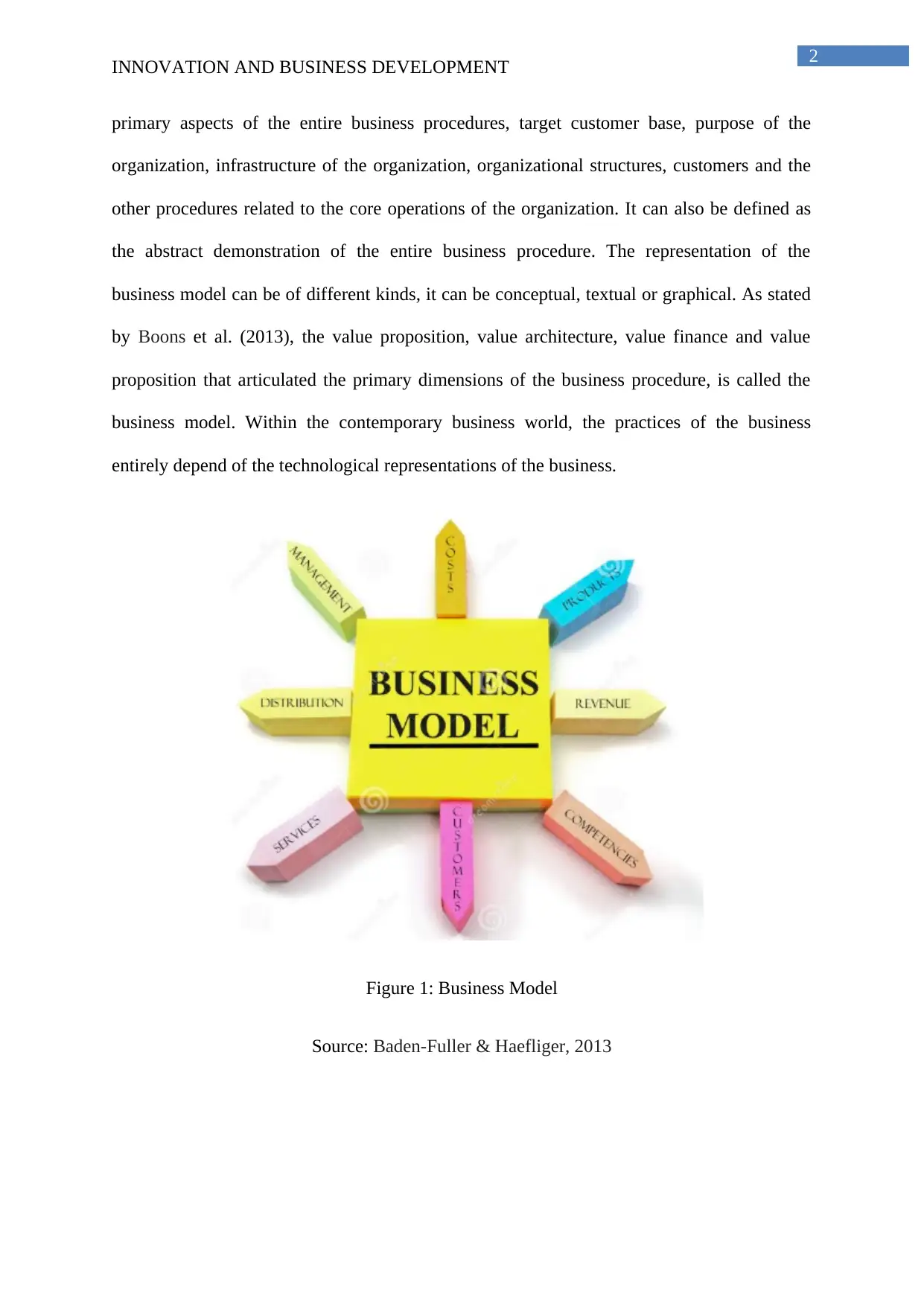
2
INNOVATION AND BUSINESS DEVELOPMENT
primary aspects of the entire business procedures, target customer base, purpose of the
organization, infrastructure of the organization, organizational structures, customers and the
other procedures related to the core operations of the organization. It can also be defined as
the abstract demonstration of the entire business procedure. The representation of the
business model can be of different kinds, it can be conceptual, textual or graphical. As stated
by Boons et al. (2013), the value proposition, value architecture, value finance and value
proposition that articulated the primary dimensions of the business procedure, is called the
business model. Within the contemporary business world, the practices of the business
entirely depend of the technological representations of the business.
Figure 1: Business Model
Source: Baden-Fuller & Haefliger, 2013
INNOVATION AND BUSINESS DEVELOPMENT
primary aspects of the entire business procedures, target customer base, purpose of the
organization, infrastructure of the organization, organizational structures, customers and the
other procedures related to the core operations of the organization. It can also be defined as
the abstract demonstration of the entire business procedure. The representation of the
business model can be of different kinds, it can be conceptual, textual or graphical. As stated
by Boons et al. (2013), the value proposition, value architecture, value finance and value
proposition that articulated the primary dimensions of the business procedure, is called the
business model. Within the contemporary business world, the practices of the business
entirely depend of the technological representations of the business.
Figure 1: Business Model
Source: Baden-Fuller & Haefliger, 2013
⊘ This is a preview!⊘
Do you want full access?
Subscribe today to unlock all pages.

Trusted by 1+ million students worldwide
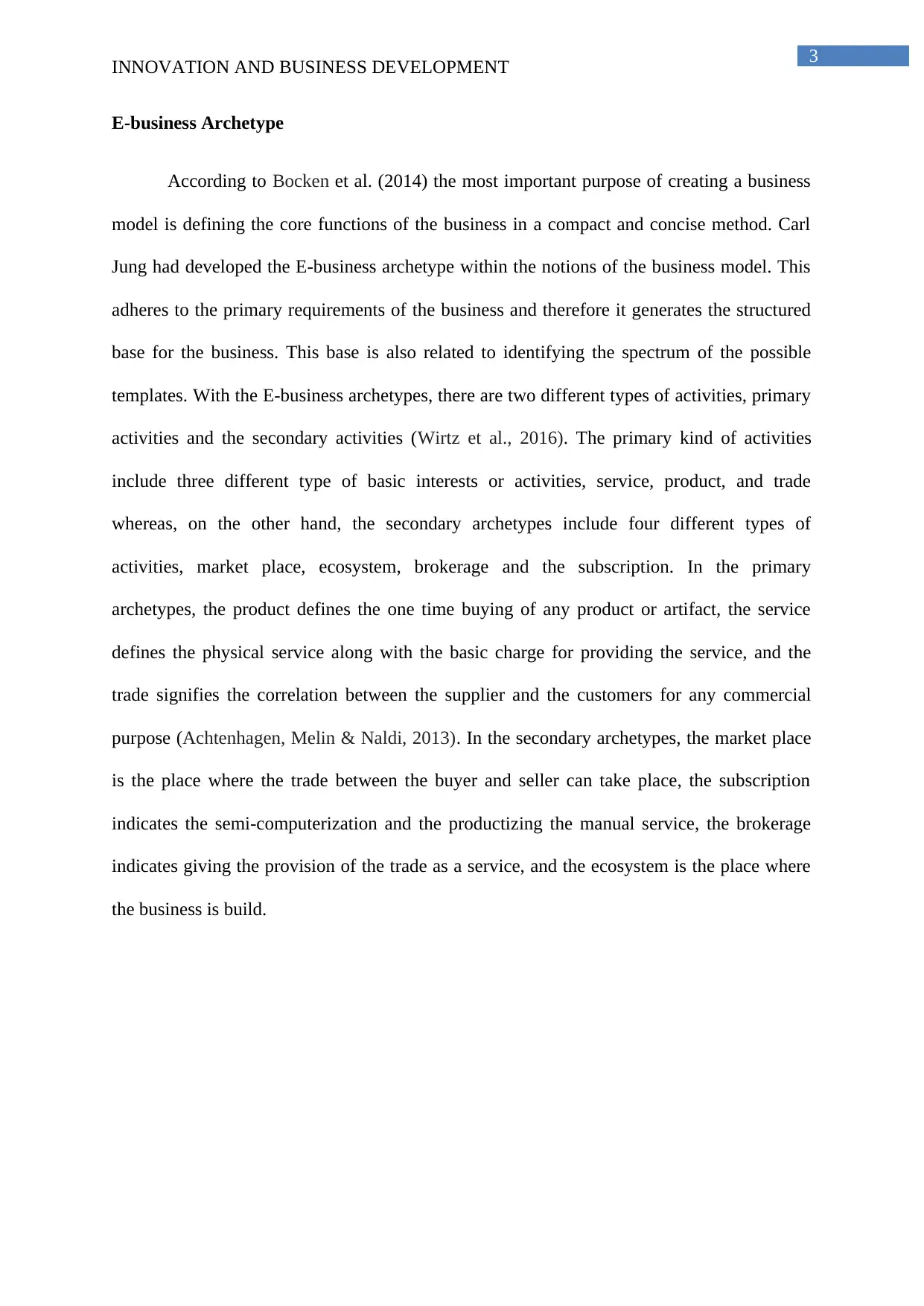
3
INNOVATION AND BUSINESS DEVELOPMENT
E-business Archetype
According to Bocken et al. (2014) the most important purpose of creating a business
model is defining the core functions of the business in a compact and concise method. Carl
Jung had developed the E-business archetype within the notions of the business model. This
adheres to the primary requirements of the business and therefore it generates the structured
base for the business. This base is also related to identifying the spectrum of the possible
templates. With the E-business archetypes, there are two different types of activities, primary
activities and the secondary activities (Wirtz et al., 2016). The primary kind of activities
include three different type of basic interests or activities, service, product, and trade
whereas, on the other hand, the secondary archetypes include four different types of
activities, market place, ecosystem, brokerage and the subscription. In the primary
archetypes, the product defines the one time buying of any product or artifact, the service
defines the physical service along with the basic charge for providing the service, and the
trade signifies the correlation between the supplier and the customers for any commercial
purpose (Achtenhagen, Melin & Naldi, 2013). In the secondary archetypes, the market place
is the place where the trade between the buyer and seller can take place, the subscription
indicates the semi-computerization and the productizing the manual service, the brokerage
indicates giving the provision of the trade as a service, and the ecosystem is the place where
the business is build.
INNOVATION AND BUSINESS DEVELOPMENT
E-business Archetype
According to Bocken et al. (2014) the most important purpose of creating a business
model is defining the core functions of the business in a compact and concise method. Carl
Jung had developed the E-business archetype within the notions of the business model. This
adheres to the primary requirements of the business and therefore it generates the structured
base for the business. This base is also related to identifying the spectrum of the possible
templates. With the E-business archetypes, there are two different types of activities, primary
activities and the secondary activities (Wirtz et al., 2016). The primary kind of activities
include three different type of basic interests or activities, service, product, and trade
whereas, on the other hand, the secondary archetypes include four different types of
activities, market place, ecosystem, brokerage and the subscription. In the primary
archetypes, the product defines the one time buying of any product or artifact, the service
defines the physical service along with the basic charge for providing the service, and the
trade signifies the correlation between the supplier and the customers for any commercial
purpose (Achtenhagen, Melin & Naldi, 2013). In the secondary archetypes, the market place
is the place where the trade between the buyer and seller can take place, the subscription
indicates the semi-computerization and the productizing the manual service, the brokerage
indicates giving the provision of the trade as a service, and the ecosystem is the place where
the business is build.
Paraphrase This Document
Need a fresh take? Get an instant paraphrase of this document with our AI Paraphraser
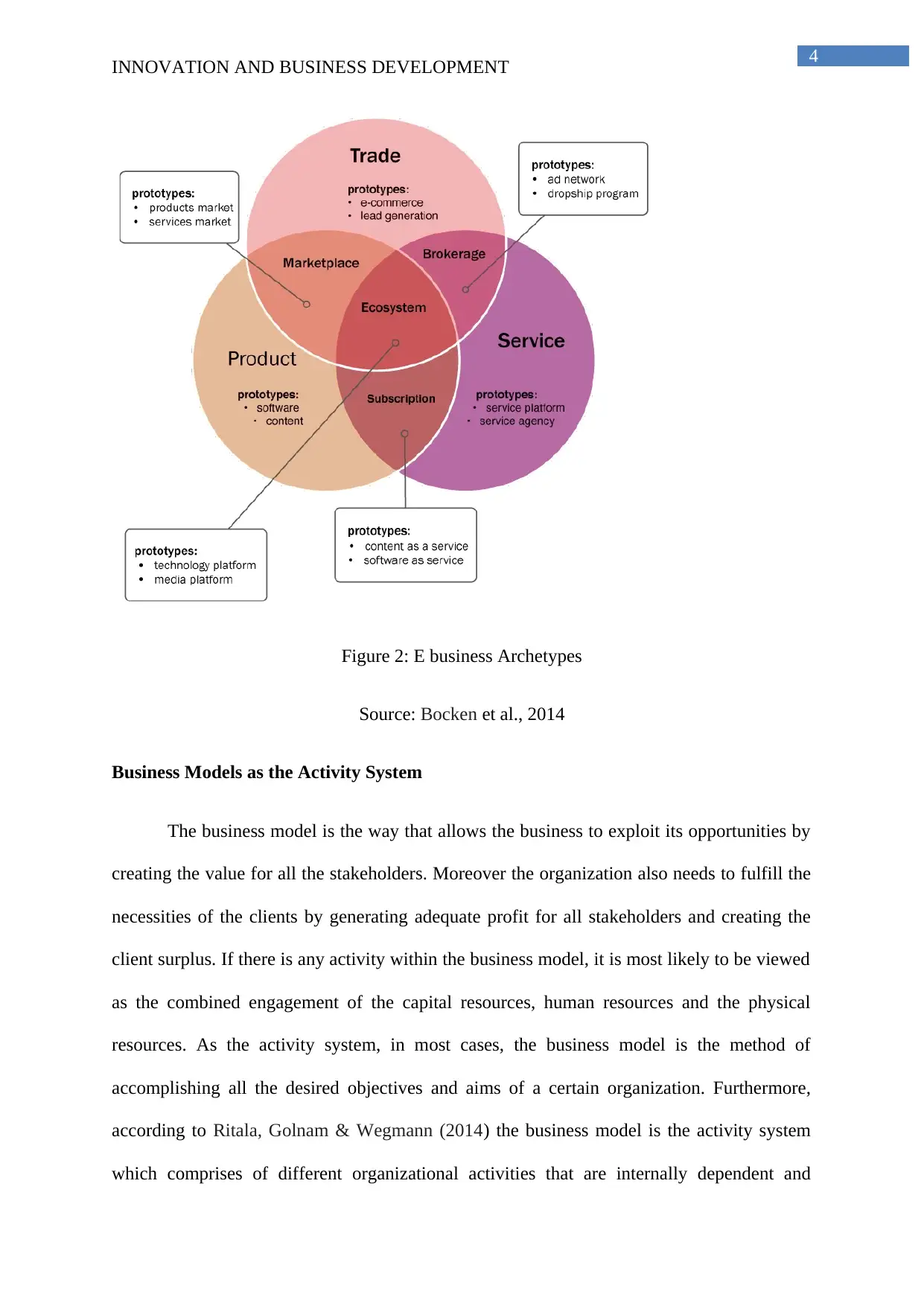
4
INNOVATION AND BUSINESS DEVELOPMENT
Figure 2: E business Archetypes
Source: Bocken et al., 2014
Business Models as the Activity System
The business model is the way that allows the business to exploit its opportunities by
creating the value for all the stakeholders. Moreover the organization also needs to fulfill the
necessities of the clients by generating adequate profit for all stakeholders and creating the
client surplus. If there is any activity within the business model, it is most likely to be viewed
as the combined engagement of the capital resources, human resources and the physical
resources. As the activity system, in most cases, the business model is the method of
accomplishing all the desired objectives and aims of a certain organization. Furthermore,
according to Ritala, Golnam & Wegmann (2014) the business model is the activity system
which comprises of different organizational activities that are internally dependent and
INNOVATION AND BUSINESS DEVELOPMENT
Figure 2: E business Archetypes
Source: Bocken et al., 2014
Business Models as the Activity System
The business model is the way that allows the business to exploit its opportunities by
creating the value for all the stakeholders. Moreover the organization also needs to fulfill the
necessities of the clients by generating adequate profit for all stakeholders and creating the
client surplus. If there is any activity within the business model, it is most likely to be viewed
as the combined engagement of the capital resources, human resources and the physical
resources. As the activity system, in most cases, the business model is the method of
accomplishing all the desired objectives and aims of a certain organization. Furthermore,
according to Ritala, Golnam & Wegmann (2014) the business model is the activity system
which comprises of different organizational activities that are internally dependent and
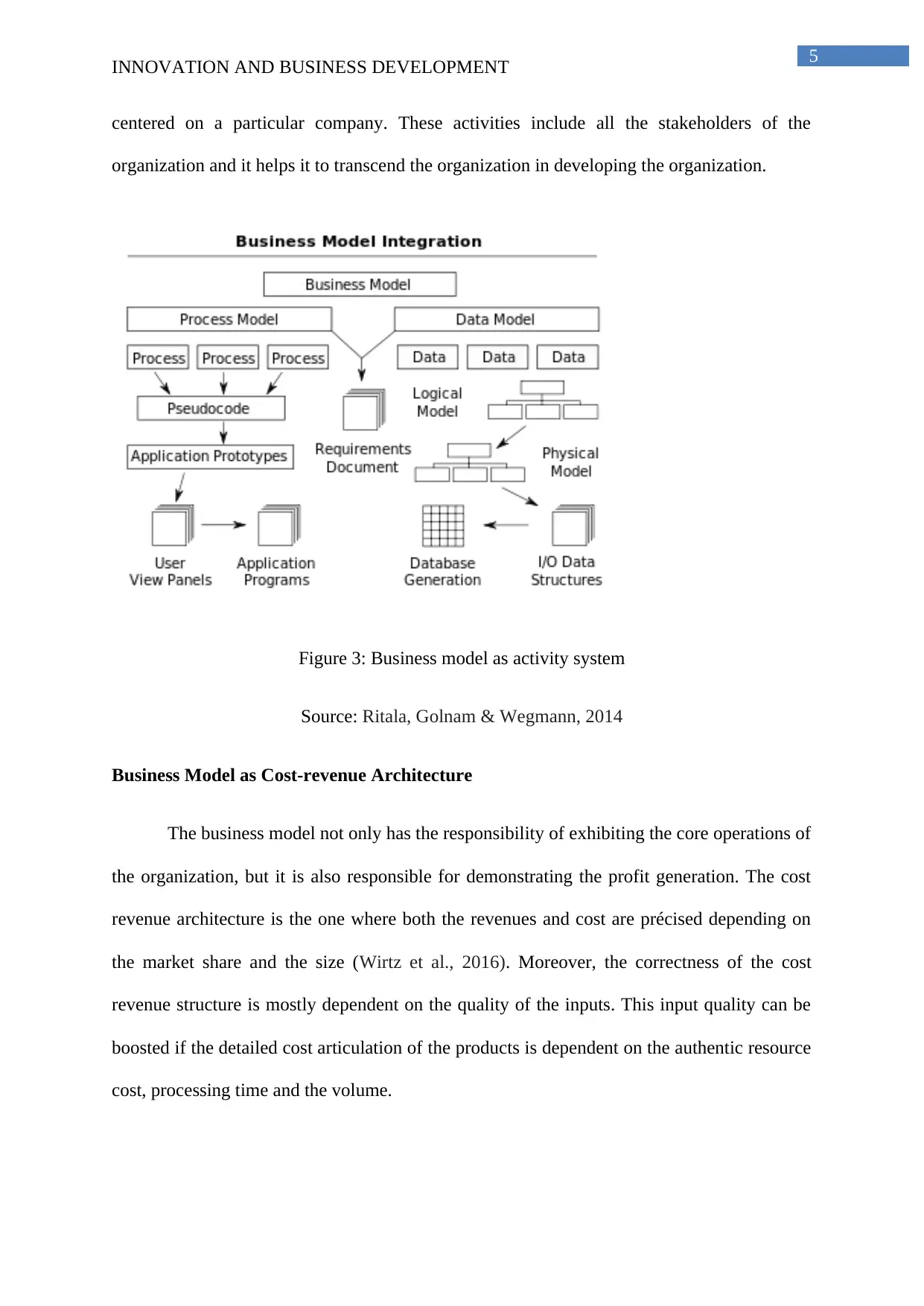
5
INNOVATION AND BUSINESS DEVELOPMENT
centered on a particular company. These activities include all the stakeholders of the
organization and it helps it to transcend the organization in developing the organization.
Figure 3: Business model as activity system
Source: Ritala, Golnam & Wegmann, 2014
Business Model as Cost-revenue Architecture
The business model not only has the responsibility of exhibiting the core operations of
the organization, but it is also responsible for demonstrating the profit generation. The cost
revenue architecture is the one where both the revenues and cost are précised depending on
the market share and the size (Wirtz et al., 2016). Moreover, the correctness of the cost
revenue structure is mostly dependent on the quality of the inputs. This input quality can be
boosted if the detailed cost articulation of the products is dependent on the authentic resource
cost, processing time and the volume.
INNOVATION AND BUSINESS DEVELOPMENT
centered on a particular company. These activities include all the stakeholders of the
organization and it helps it to transcend the organization in developing the organization.
Figure 3: Business model as activity system
Source: Ritala, Golnam & Wegmann, 2014
Business Model as Cost-revenue Architecture
The business model not only has the responsibility of exhibiting the core operations of
the organization, but it is also responsible for demonstrating the profit generation. The cost
revenue architecture is the one where both the revenues and cost are précised depending on
the market share and the size (Wirtz et al., 2016). Moreover, the correctness of the cost
revenue structure is mostly dependent on the quality of the inputs. This input quality can be
boosted if the detailed cost articulation of the products is dependent on the authentic resource
cost, processing time and the volume.
⊘ This is a preview!⊘
Do you want full access?
Subscribe today to unlock all pages.

Trusted by 1+ million students worldwide
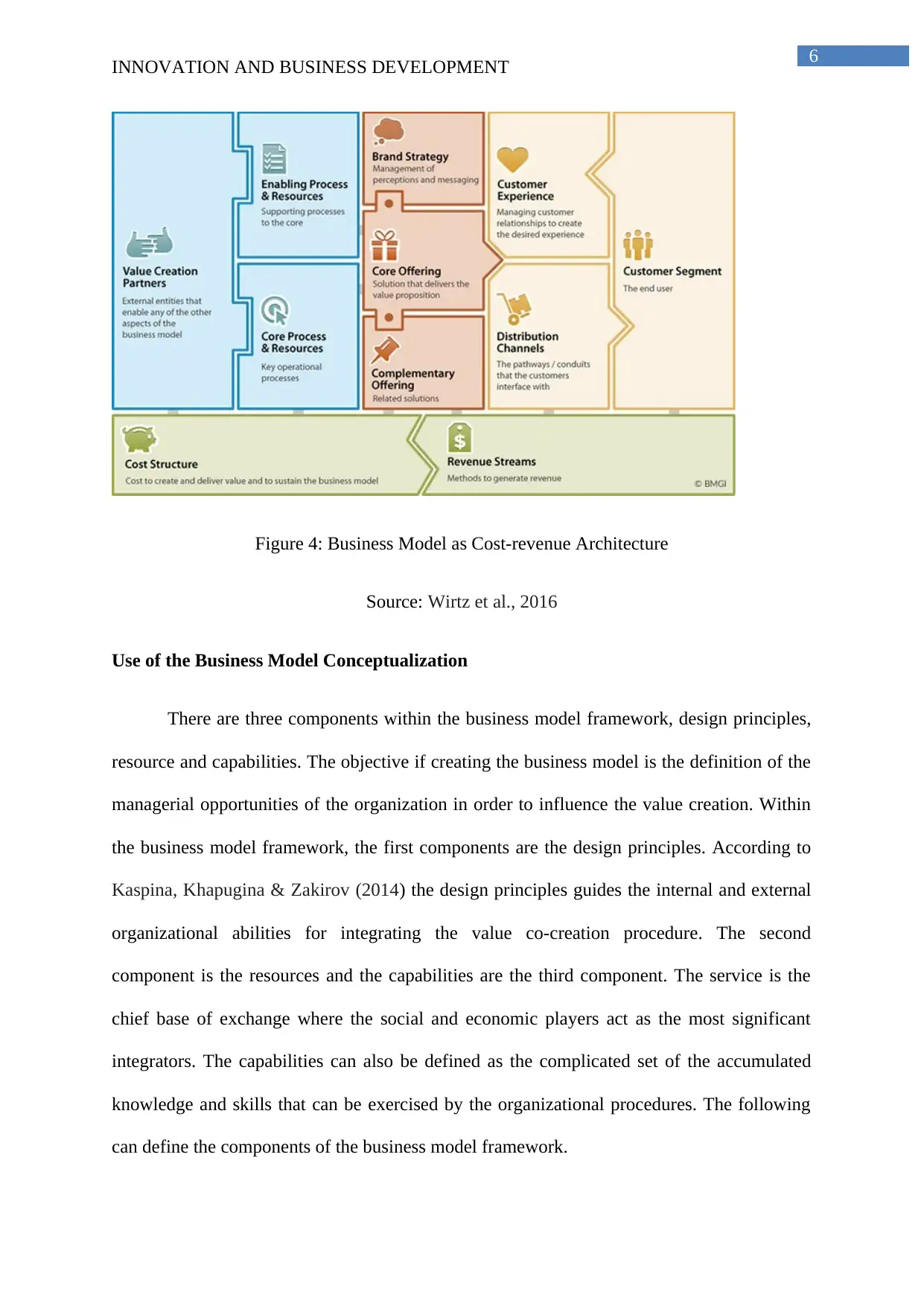
6
INNOVATION AND BUSINESS DEVELOPMENT
Figure 4: Business Model as Cost-revenue Architecture
Source: Wirtz et al., 2016
Use of the Business Model Conceptualization
There are three components within the business model framework, design principles,
resource and capabilities. The objective if creating the business model is the definition of the
managerial opportunities of the organization in order to influence the value creation. Within
the business model framework, the first components are the design principles. According to
Kaspina, Khapugina & Zakirov (2014) the design principles guides the internal and external
organizational abilities for integrating the value co-creation procedure. The second
component is the resources and the capabilities are the third component. The service is the
chief base of exchange where the social and economic players act as the most significant
integrators. The capabilities can also be defined as the complicated set of the accumulated
knowledge and skills that can be exercised by the organizational procedures. The following
can define the components of the business model framework.
INNOVATION AND BUSINESS DEVELOPMENT
Figure 4: Business Model as Cost-revenue Architecture
Source: Wirtz et al., 2016
Use of the Business Model Conceptualization
There are three components within the business model framework, design principles,
resource and capabilities. The objective if creating the business model is the definition of the
managerial opportunities of the organization in order to influence the value creation. Within
the business model framework, the first components are the design principles. According to
Kaspina, Khapugina & Zakirov (2014) the design principles guides the internal and external
organizational abilities for integrating the value co-creation procedure. The second
component is the resources and the capabilities are the third component. The service is the
chief base of exchange where the social and economic players act as the most significant
integrators. The capabilities can also be defined as the complicated set of the accumulated
knowledge and skills that can be exercised by the organizational procedures. The following
can define the components of the business model framework.
Paraphrase This Document
Need a fresh take? Get an instant paraphrase of this document with our AI Paraphraser
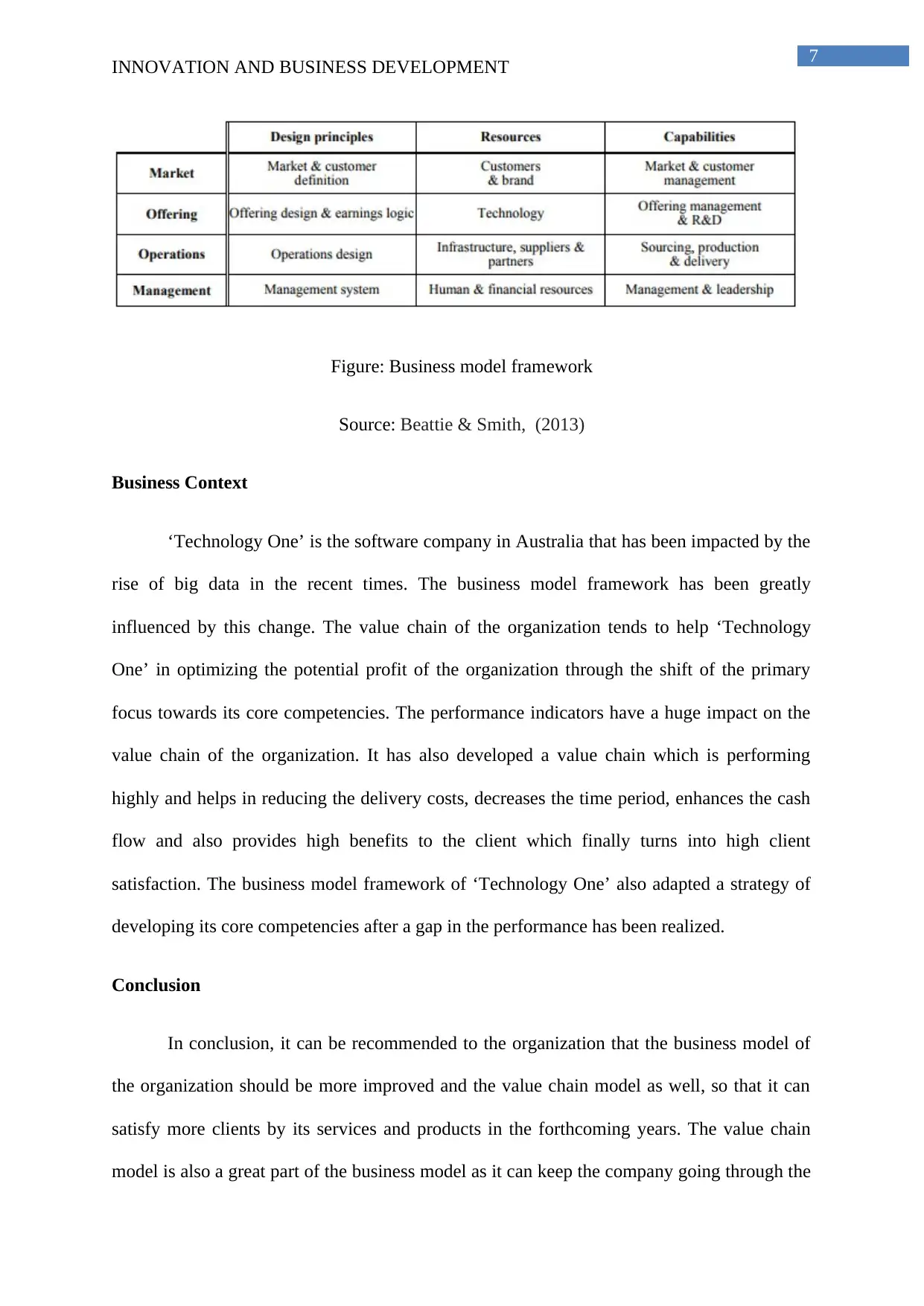
7
INNOVATION AND BUSINESS DEVELOPMENT
Figure: Business model framework
Source: Beattie & Smith, (2013)
Business Context
‘Technology One’ is the software company in Australia that has been impacted by the
rise of big data in the recent times. The business model framework has been greatly
influenced by this change. The value chain of the organization tends to help ‘Technology
One’ in optimizing the potential profit of the organization through the shift of the primary
focus towards its core competencies. The performance indicators have a huge impact on the
value chain of the organization. It has also developed a value chain which is performing
highly and helps in reducing the delivery costs, decreases the time period, enhances the cash
flow and also provides high benefits to the client which finally turns into high client
satisfaction. The business model framework of ‘Technology One’ also adapted a strategy of
developing its core competencies after a gap in the performance has been realized.
Conclusion
In conclusion, it can be recommended to the organization that the business model of
the organization should be more improved and the value chain model as well, so that it can
satisfy more clients by its services and products in the forthcoming years. The value chain
model is also a great part of the business model as it can keep the company going through the
INNOVATION AND BUSINESS DEVELOPMENT
Figure: Business model framework
Source: Beattie & Smith, (2013)
Business Context
‘Technology One’ is the software company in Australia that has been impacted by the
rise of big data in the recent times. The business model framework has been greatly
influenced by this change. The value chain of the organization tends to help ‘Technology
One’ in optimizing the potential profit of the organization through the shift of the primary
focus towards its core competencies. The performance indicators have a huge impact on the
value chain of the organization. It has also developed a value chain which is performing
highly and helps in reducing the delivery costs, decreases the time period, enhances the cash
flow and also provides high benefits to the client which finally turns into high client
satisfaction. The business model framework of ‘Technology One’ also adapted a strategy of
developing its core competencies after a gap in the performance has been realized.
Conclusion
In conclusion, it can be recommended to the organization that the business model of
the organization should be more improved and the value chain model as well, so that it can
satisfy more clients by its services and products in the forthcoming years. The value chain
model is also a great part of the business model as it can keep the company going through the
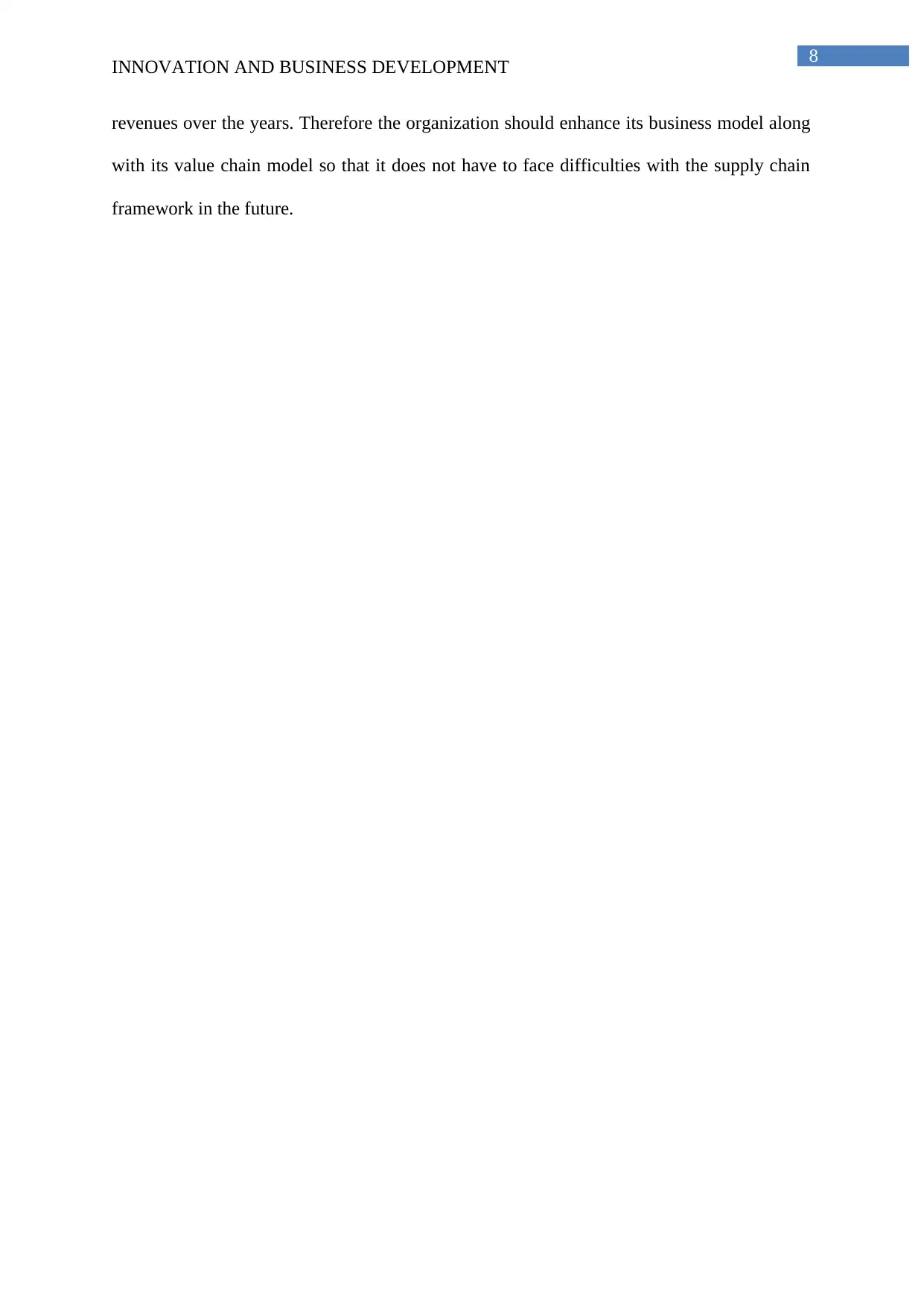
8
INNOVATION AND BUSINESS DEVELOPMENT
revenues over the years. Therefore the organization should enhance its business model along
with its value chain model so that it does not have to face difficulties with the supply chain
framework in the future.
INNOVATION AND BUSINESS DEVELOPMENT
revenues over the years. Therefore the organization should enhance its business model along
with its value chain model so that it does not have to face difficulties with the supply chain
framework in the future.
⊘ This is a preview!⊘
Do you want full access?
Subscribe today to unlock all pages.

Trusted by 1+ million students worldwide
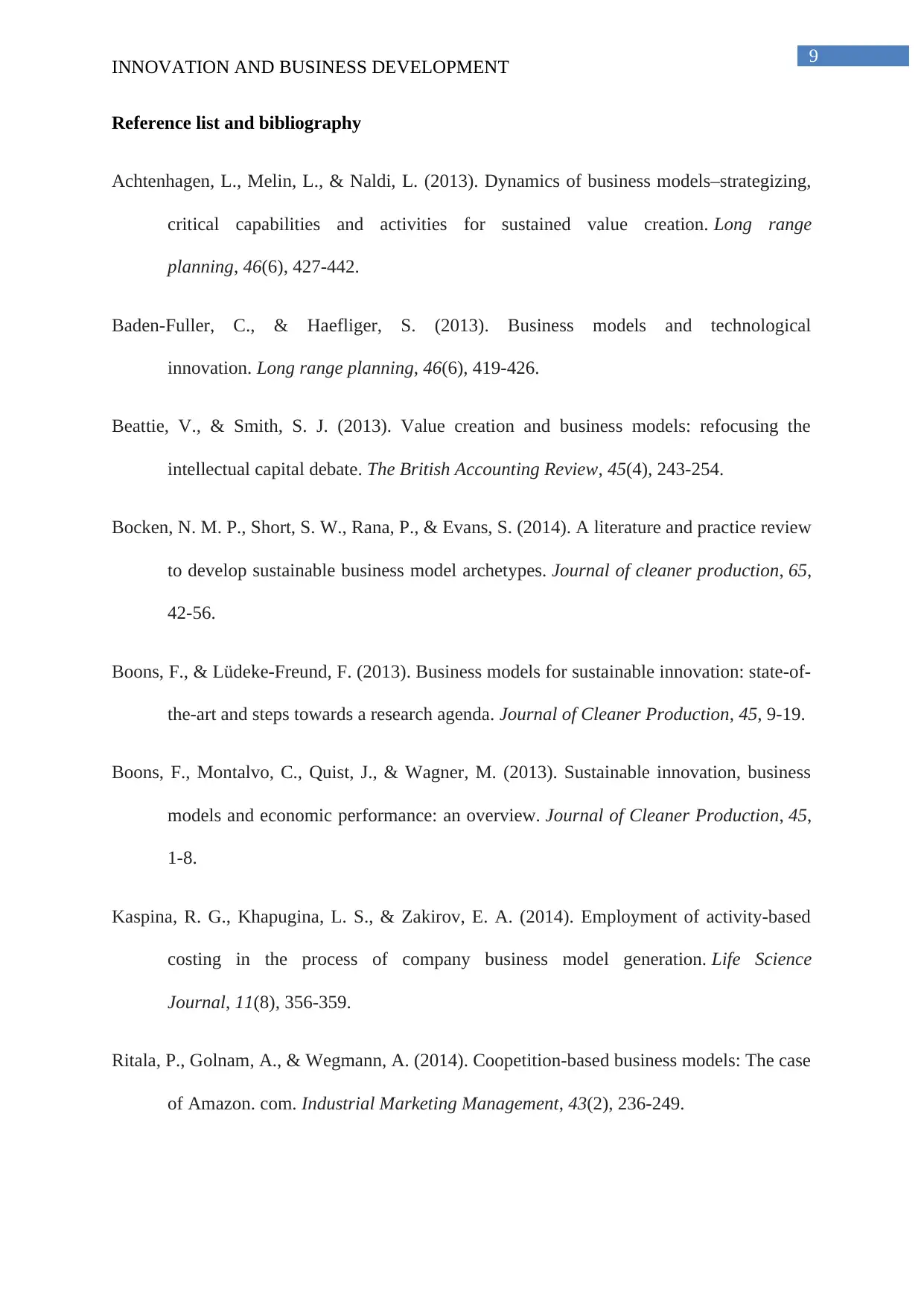
9
INNOVATION AND BUSINESS DEVELOPMENT
Reference list and bibliography
Achtenhagen, L., Melin, L., & Naldi, L. (2013). Dynamics of business models–strategizing,
critical capabilities and activities for sustained value creation. Long range
planning, 46(6), 427-442.
Baden-Fuller, C., & Haefliger, S. (2013). Business models and technological
innovation. Long range planning, 46(6), 419-426.
Beattie, V., & Smith, S. J. (2013). Value creation and business models: refocusing the
intellectual capital debate. The British Accounting Review, 45(4), 243-254.
Bocken, N. M. P., Short, S. W., Rana, P., & Evans, S. (2014). A literature and practice review
to develop sustainable business model archetypes. Journal of cleaner production, 65,
42-56.
Boons, F., & Lüdeke-Freund, F. (2013). Business models for sustainable innovation: state-of-
the-art and steps towards a research agenda. Journal of Cleaner Production, 45, 9-19.
Boons, F., Montalvo, C., Quist, J., & Wagner, M. (2013). Sustainable innovation, business
models and economic performance: an overview. Journal of Cleaner Production, 45,
1-8.
Kaspina, R. G., Khapugina, L. S., & Zakirov, E. A. (2014). Employment of activity-based
costing in the process of company business model generation. Life Science
Journal, 11(8), 356-359.
Ritala, P., Golnam, A., & Wegmann, A. (2014). Coopetition-based business models: The case
of Amazon. com. Industrial Marketing Management, 43(2), 236-249.
INNOVATION AND BUSINESS DEVELOPMENT
Reference list and bibliography
Achtenhagen, L., Melin, L., & Naldi, L. (2013). Dynamics of business models–strategizing,
critical capabilities and activities for sustained value creation. Long range
planning, 46(6), 427-442.
Baden-Fuller, C., & Haefliger, S. (2013). Business models and technological
innovation. Long range planning, 46(6), 419-426.
Beattie, V., & Smith, S. J. (2013). Value creation and business models: refocusing the
intellectual capital debate. The British Accounting Review, 45(4), 243-254.
Bocken, N. M. P., Short, S. W., Rana, P., & Evans, S. (2014). A literature and practice review
to develop sustainable business model archetypes. Journal of cleaner production, 65,
42-56.
Boons, F., & Lüdeke-Freund, F. (2013). Business models for sustainable innovation: state-of-
the-art and steps towards a research agenda. Journal of Cleaner Production, 45, 9-19.
Boons, F., Montalvo, C., Quist, J., & Wagner, M. (2013). Sustainable innovation, business
models and economic performance: an overview. Journal of Cleaner Production, 45,
1-8.
Kaspina, R. G., Khapugina, L. S., & Zakirov, E. A. (2014). Employment of activity-based
costing in the process of company business model generation. Life Science
Journal, 11(8), 356-359.
Ritala, P., Golnam, A., & Wegmann, A. (2014). Coopetition-based business models: The case
of Amazon. com. Industrial Marketing Management, 43(2), 236-249.
Paraphrase This Document
Need a fresh take? Get an instant paraphrase of this document with our AI Paraphraser

10
INNOVATION AND BUSINESS DEVELOPMENT
Wirtz, B. W., Pistoia, A., Ullrich, S., & Göttel, V. (2016). Business models: Origin,
development and future research perspectives. Long Range Planning, 49(1), 36-54.
Wirtz, B. W., Pistoia, A., Ullrich, S., & Göttel, V. (2016). Business models: Origin,
development and future research perspectives. Long Range Planning, 49(1), 36-54.
INNOVATION AND BUSINESS DEVELOPMENT
Wirtz, B. W., Pistoia, A., Ullrich, S., & Göttel, V. (2016). Business models: Origin,
development and future research perspectives. Long Range Planning, 49(1), 36-54.
Wirtz, B. W., Pistoia, A., Ullrich, S., & Göttel, V. (2016). Business models: Origin,
development and future research perspectives. Long Range Planning, 49(1), 36-54.
1 out of 11
Related Documents
Your All-in-One AI-Powered Toolkit for Academic Success.
+13062052269
info@desklib.com
Available 24*7 on WhatsApp / Email
![[object Object]](/_next/static/media/star-bottom.7253800d.svg)
Unlock your academic potential
Copyright © 2020–2025 A2Z Services. All Rights Reserved. Developed and managed by ZUCOL.





